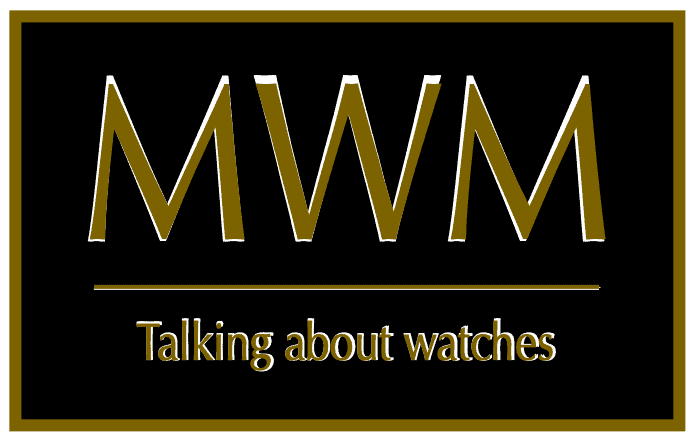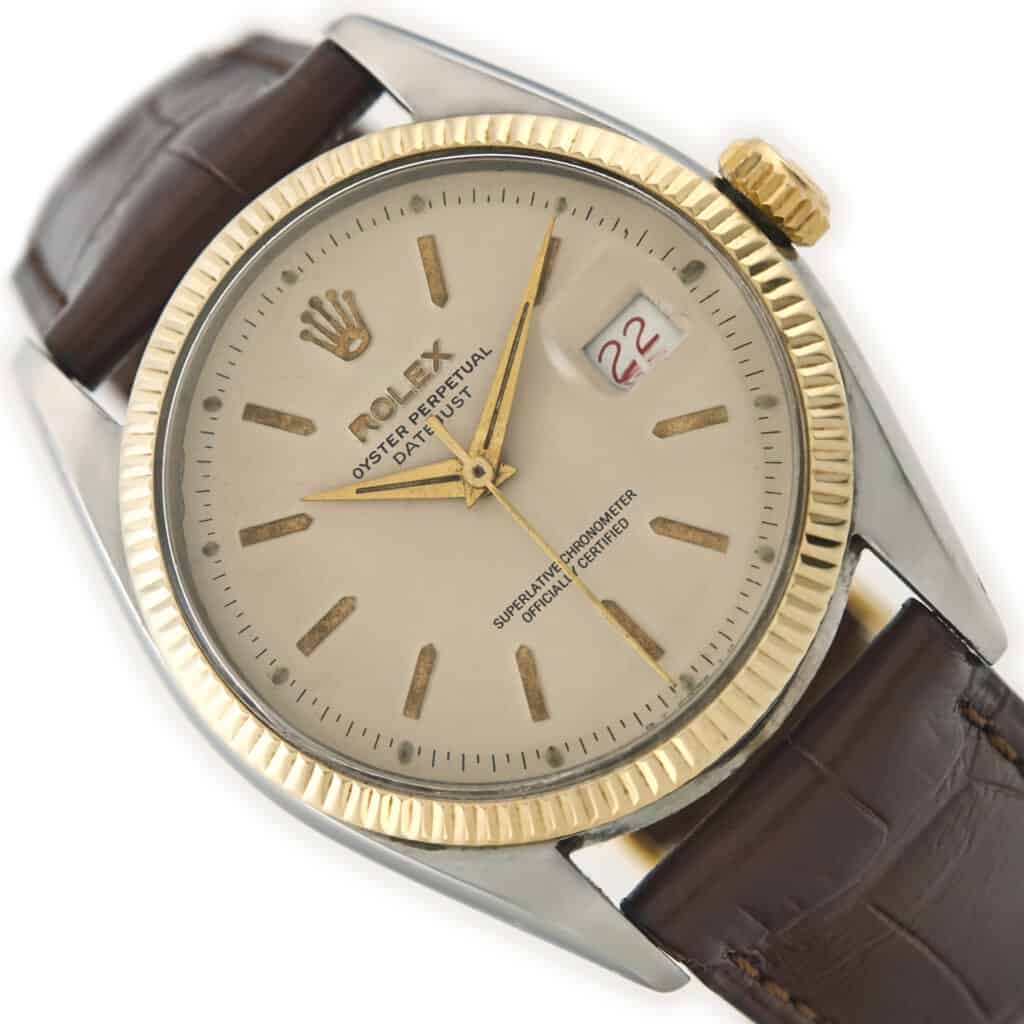By Alan Wood
Get a clear definition of chronographs and chronometers, how they differ, and why they are important features to understand in the watch world.

Alan Wood (above) is a trusted vintage watch dealer with over 35 years of private collecting experience. After founding Vintage Gold Watches in 2011, his deep knowledge and infectious passion for mechanical timepieces earned him a highly respected reputation in the industry. Vintage Gold Watches has become a renowned dealer thanks to Alan’s expertise and skilled team of restorers. Alan’s love for vintage watches started as a young Mechanical Entrepreneur and grew into an obsession. He believes the finest watches were made in the 1950s, 60s, and 70s, and is thrilled to share them with others.
Chronometer Vs Chronograph: Understanding Precision And Performance
Clients often ask us to explain the difference between chronometers and chronographs. These commonly confused horological terms sound similar but actually refer to very different aspects of a watch’s precision and performance.
It’s possible that you may be misusing these terms, assuming they are interconnected, or perhaps you are unfamiliar with them altogether. Although both terms share the common prefix ‘chrono’, indicating ‘time’, it’s easy to confuse them. However, it’s crucial to recognise that each term holds its distinct meaning.
The first thing to know is that a chronometer rating gauges the accuracy of a watch and guarantees that the watch meets the high standards needed to receive a chronometer rating. The independent testing, carried out by an official organisation, analyses the movement under strictly defined rules. It has nothing to do with the functions of a watch and everything to do with performance and accuracy.
On the contrary, a chronograph denotes a function inherent to a watch, signifying its capability or, more precisely, a horological complication. It’s important to note that a complication refers to any feature in a mechanical watch that goes beyond the basic display of hours, minutes, or seconds. So, even the most straightforward date mechanism qualifies as a complication in this context.
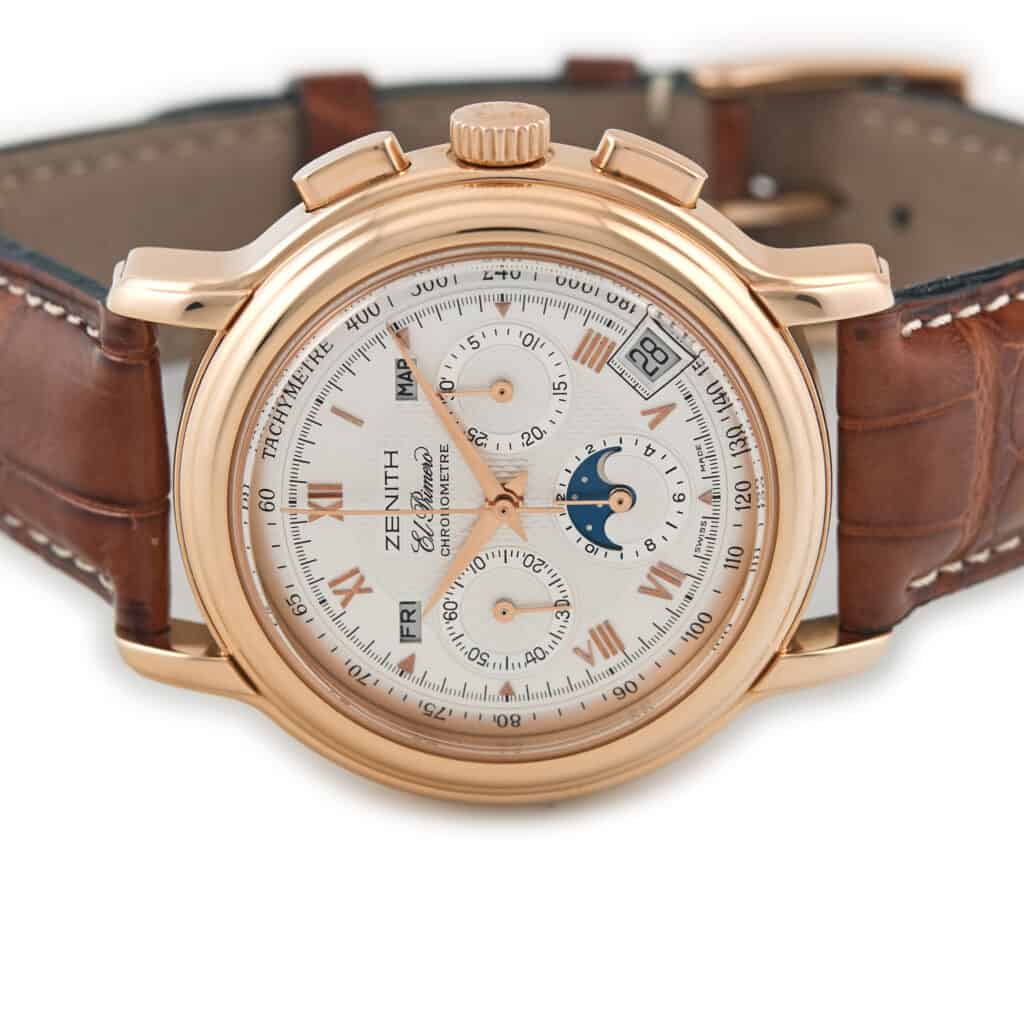
Above: The chronometer rated Zenith El Primero
Understanding Chronometers
The term chronometer is a rating of accuracy. A watch referred to as a chronometer, or that has a chronometer certification, is a watch that has passed a variety of precision tests and is proven to be highly accurate. Only the most accurate and well-made timepieces meet this exacting standard, with only 6% of all Swiss watches that are exported for sale receiving a chronometer rating, according to the COSC.
It’s worth noting what prompted the need for a chronometer rating to be established in the first place. Time is based on agreed fixed and precise calculations and, therefore, is accurate and never changes. Mechanical watches are, like all mechanical things, relying on moving parts, be it a car engine or vintage Rolex, subject to the effects of internal and external forces that impact their accuracy.
The movement in a mechanical watch is a piece of micro-mechanics. Friction is one example of an internal force that affects accuracy. Friction will increase over time as oils degrade and the moving parts become subject to wear. A movement is also subject to external factors, like humidity, pressure, magnetism, heat/cold or gravity. As it is a mechanical engine it will never be able to offer 100% accurate performance.
So, time is fixed and accurate, and the measurement of time in a mechanical watch can never be 100% precise due to the nature of mechanics. Achieving 100% accuracy in measuring time within a mechanical watch has been an enduring challenge for watchmakers. The inherent nature of mechanical watches makes them inevitably inaccurate. The interplay between the pursuit of precision and the inherent inaccuracy of mechanical watches created the question of “How inaccurate?” a crucial consideration for both watchmakers and owners. This quest for precision ultimately gave rise to the development of the chronometer.
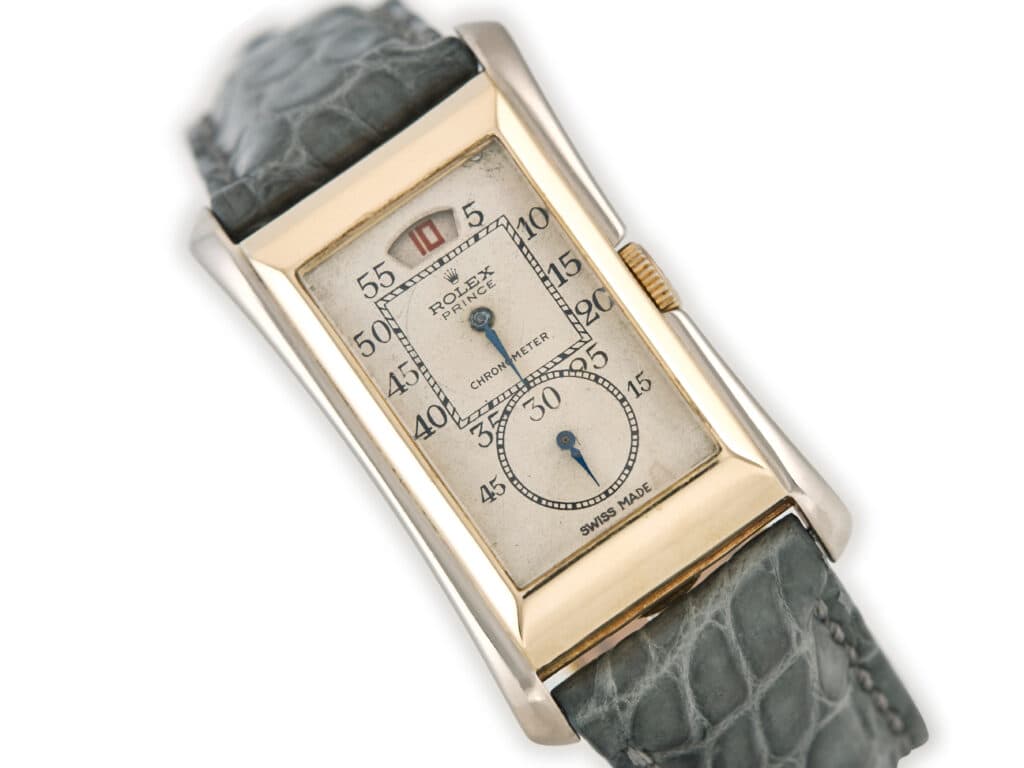
Above: Rolex Prince Jump Hour Chronometer 18ct Yellow and White Gold c.1930
The Chronometer Certification
Various organisations carry out chronometer certification testing, on behalf of watch manufacturers. Through extensive testing of the movement and rate measurements, it can be determined whether it is consistent with the chronometer standards. After having passed the examination, a tested movement receives an official certification. In most cases, the watch manufacturer will print the term ‘chronometer’ on the watch’s dial because the chronometer rating is held in such high esteem. It is really a sign of true watchmaking excellence.
The COSC (Contrôle Officiel Suisse des Chronomètres) is the most well-known chronometer testing organisation. Based in Switzerland, it was founded in 1979 with the aim of standardising chronometer testing and bringing together various watch testing laboratories within one organisation. The COSC is an independent non-profit-making organisation, as such, it is vital to Swiss watchmaking as it ensures a level of excellence is maintained within the industry.
Today, chronometer testing is defined by the international standard ISO 3159, which stipulates that a chronometer movement must be accurate to -4 to +6 seconds per day. The checks performed in chronometer examination consist of static tests performed in a laboratory.
Each individual watch/movement undergoes a battery of tests for several consecutive days, in five positions (3 o’clock, 6 o’clock, 9 o’clock, dial on top, dial on the bottom) and at three different temperatures (8°, 23° and 38°C). Based on the measurements recorded, 7 elimination criteria are calculated. Only if the 7 criteria are met will the watch/movement be certified as a chronometer. The criteria are:
- average daily rate
- mean variation in rates
- greatest variation in rates
- the difference between rates in horizontal and vertical positions
- largest variation in rates
- depending on temperature, a variation in rate
- rate resumption
You can read more about chronometer certification and how watches are tested on the COSC website.
Chronometers became well-known, highly appealing and aspirational in the 1950s. As high-end watches were very expensive at that time, anyone spending money on a sports watch or tool watch would expect to see the word chronometer written on the dial.
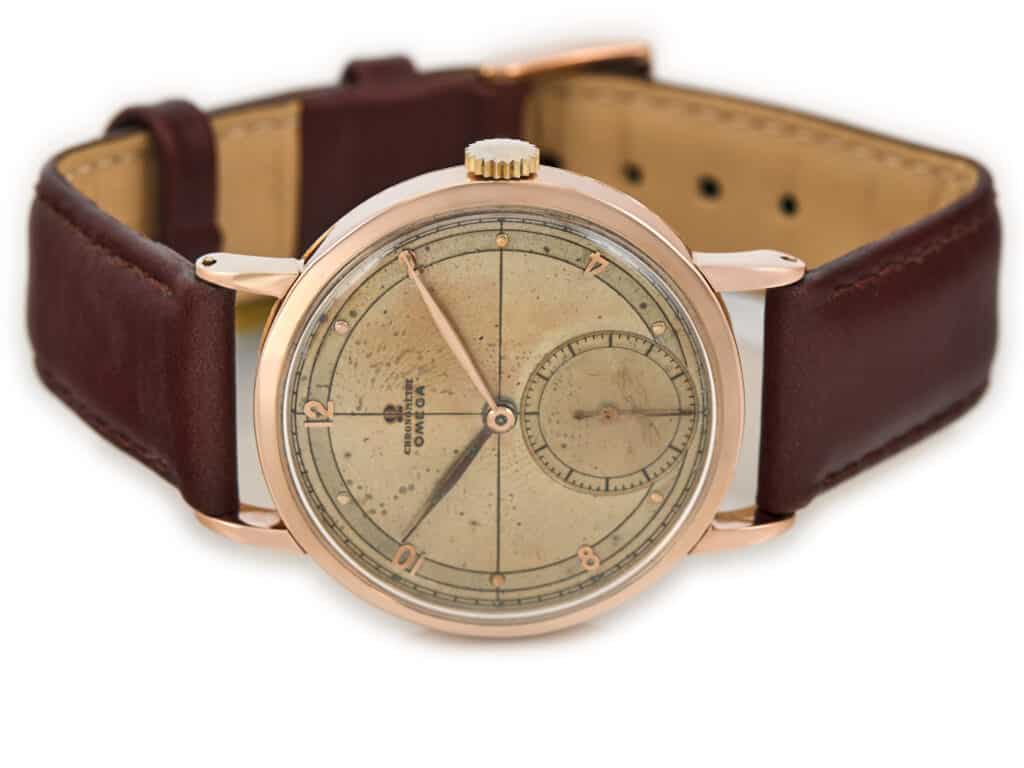
Above: The Omega Chronometer Cal.30T2 18ct Pink Gold, 1945
History of Chronographs
Chronograph is a term that describes a specific function, or complication, within a watch. ‘Chronograph’ comes from Greek and translates as ‘time writer’, but it essentially means a stopwatch.
The first chronograph was invented in 1816 by Louis Moinet. The ‘writer’ element of the translated name makes complete sense here, as the very first chronographs functioned by marking the dial with a pen attached to the index. The span of the pen mark denoted how much time had passed.
The first chronograph was created as an instrument for working with astronomy equipment. However, it was Nicolas Mathieu Rieussec, a French watchmaker, who built the first chronograph that was sold as a type of stopwatch. Commissioned by King Louis XVIII of France in 1821, Rieussec became known throughout France as the “Watchmaker to the King” because of his work.
Rieussec was tasked with creating the complication to allow the King to time horse races, a pursuit he was deeply passionate about. The outcome had a profound impact on the world of sports. Winning races was no longer determined solely by breaking through the finishing tape; the chronograph enabled precise timing, opening the door to challenging and potentially surpassing records.
In 1844, a man called Adolphe Nicole improved on Rieussec’s always-moving chronograph, which used a reset function allowing successive measurements. This opened up the way for watchmaking houses to start experimenting with chronographs.
In 1913, Longines was the first company to create a wristwatch containing a chronograph complication with its Monopusher (which only had one crown to operate the chronograph and set the time) that was accurate to 1/5th of a second. Then, Breitling released a chronograph in 1915 with the first dedicated pusher to start, stop, and reset the chronograph.
From this point forward chronographs became highly desirable and useful, not only for timing sporting events but as an aid for measuring elapsed time by doctors, pilots and the armed forces. These early chronograph watches were the first ‘tool watches’ on the market.
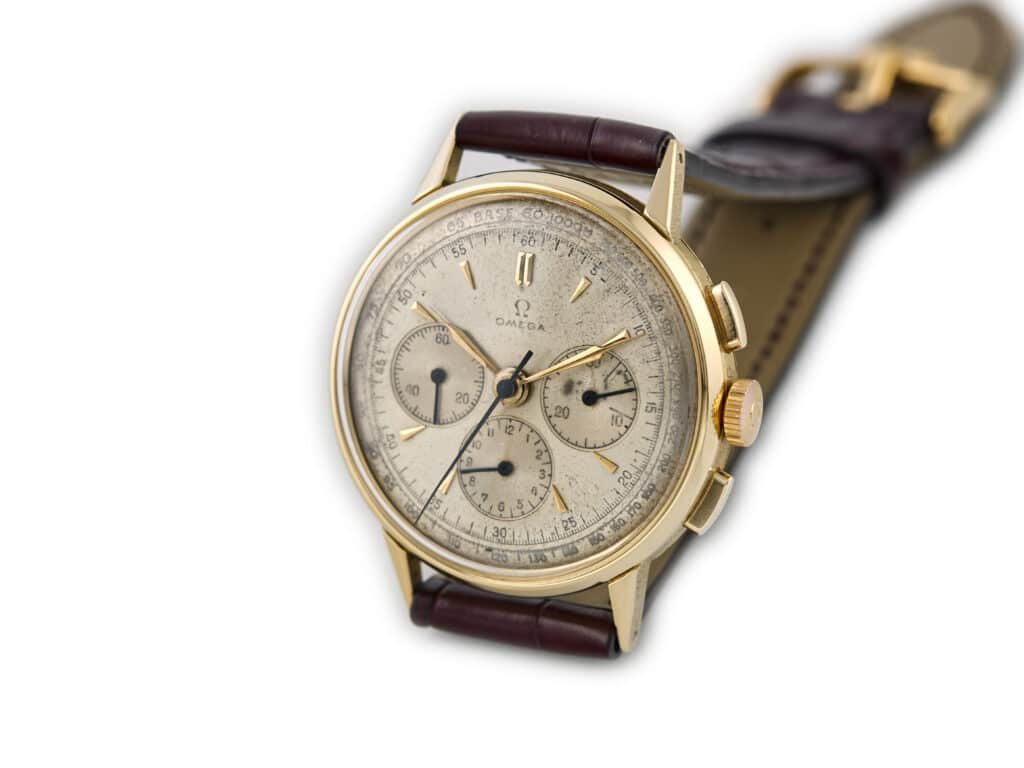
Above: A 1948 Omega Chronograph Cal.321 18ct
The Reign of Functionality
For many decades after Rieussec’s invention, watchmakers attempted to develop a wristwatch with a chronograph complication. It proved incredibly difficult due to the technical challenges of fitting such a complication inside a small wristwatch casing. The research and development needed also proved very expensive. This didn’t put the great watch manufacturers off their mission.
It wasn’t until after 1913, when Longines built their Monopusher chronograph, almost 100 years after Rieussec’s invention, that chronograph wristwatches really took off. Other brands followed over the coming decades.The tachymeter complication added a new level of functionality to the chronograph in the early twentieth century. The tachymeter is a scale marked out on the watch bezel. It allows the wearer to calculate their speed based on travel time or vice versa. This addition made the chronograph invaluable for car racing, aviation, and naval operations.
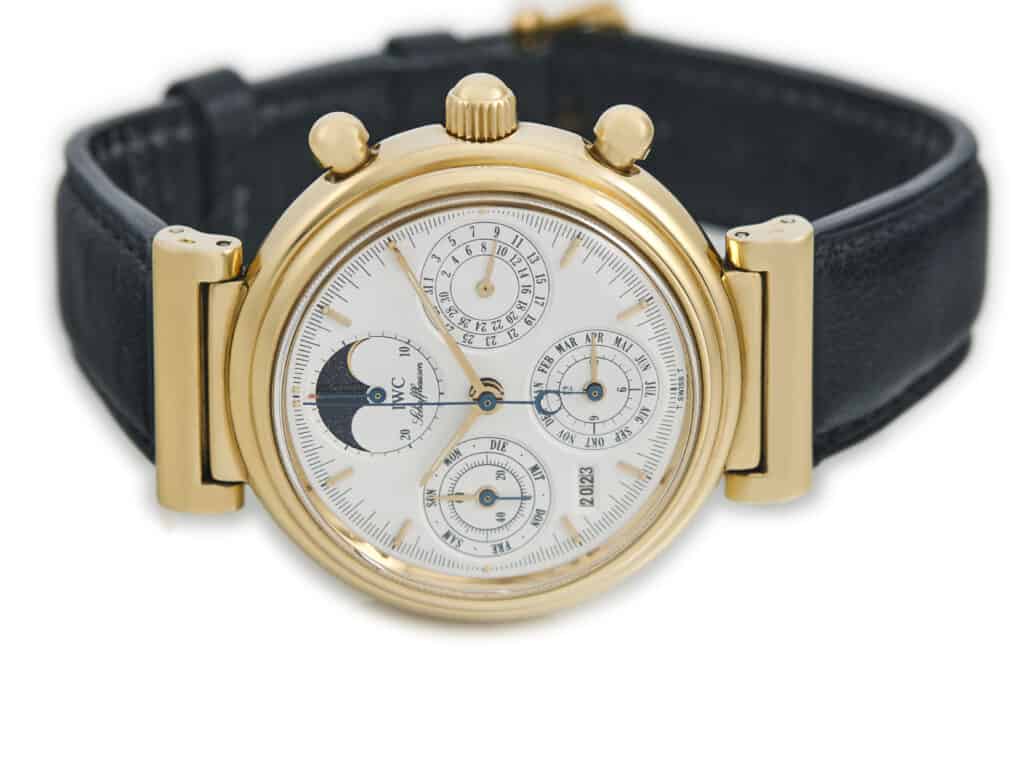
Above: The IWC Da Vinci, c.1990
Modern Day Chronographs
Up until the 1950s, chronograph watches were built for professional use and were very expensive. During the 50s, they became cheaper due to economies of scale and technological advances and so, became available to the general market, who quickly caught on. Soon, the chronograph became a standard complication that people took for granted.
From this time, most luxury watchmakers began to incorporate chronographs into many of their models. For example, the Zenith El Primero, IWC Da Vinci, Universal Geneve Calendar Chronograph, and the Jaeger-LeCoultre Chronograph Cal.285, all manufactured in the 1950s, feature chronograph complications.
In most modern mid to high-end watches, a chronograph complication comes almost as standard these days. Although the vast majority of watch wearers today probably don’t use the chronograph feature.
Typically, on modern chronograph watches, you’ll commonly find three smaller sub-dials on the watch face. Similar to regular watch hands, these sub-dials are dedicated to measuring hours, minutes, and seconds. Each hand on the chronograph sub-dial serves to track elapsed time in seconds, minutes, and hours, respectively. When the chronograph is engaged, the seconds’ dial initiates its ticking, progressing to measure minutes and eventually hours if allowed to run for an extended duration.
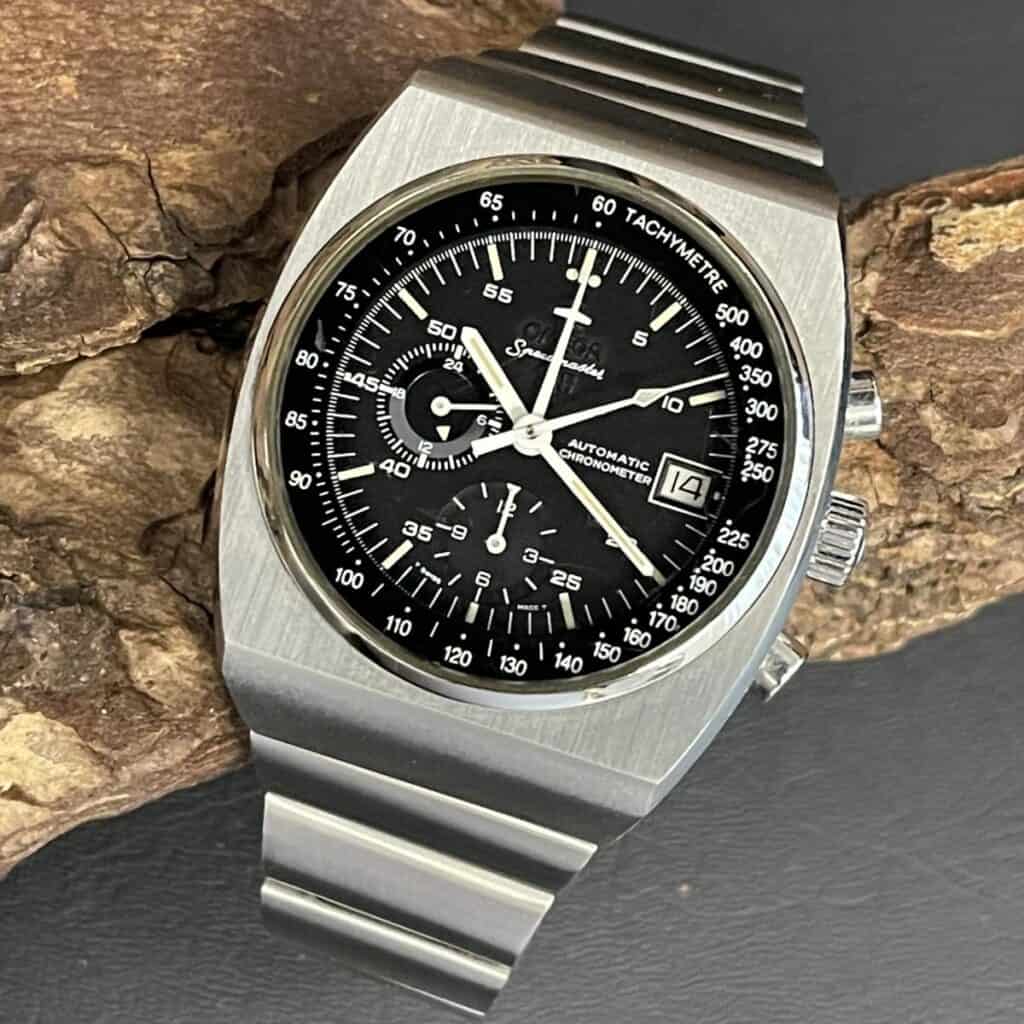
Above: The Speedmaster 125 with a chronograph complication and chronometer rating
Are Chronographs and Chronometers Incompatible?
Now that you have clear definitions of the terms chronometer and chronograph, you may be wondering if these two features are mutually exclusive – well, yes and no.
According to the COSC, a chronograph alone cannot be certified a chronometer, as the function of a chronograph is to measure short times – the duration of a particular event. At present, there is no standard to certify the precision of a chronograph.
On the other hand, high-precision watches with a chronograph function can be certified as chronometers. The Omega Speedmaster 125, introduced in 1973, was the world’s first chronometer-certified automatic chronograph watch. Another early example is the Rolex Daytona.
We hope this blog has cleared up the common confusion between these two horological terms, and you can now talk with confidence about a watch’s precision and performance using your newfound knowledge.To gain more insights into the world of vintage watches, sign up for our weekly newsletter.
